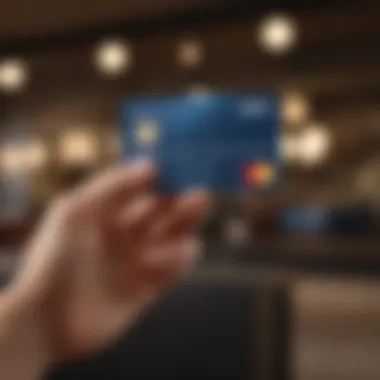Mastering the Art of Using a Virtual Visa Card: A Comprehensive Guide


Understanding Budgeting
As we embark on understanding virtual Visa card payments, it is crucial to lay a strong foundation through comprehending budgeting. Budgeting forms the backbone of financial management, instilling discipline in spending and saving habits. By delineating income streams and expenses, individuals can gain a clear perspective on their monetary inflow and outflow. This section delves into the importance of budgeting, outlining its significance in fostering financial awareness and prudence.
Importance of Budgeting
Budgeting plays a pivotal role in cultivating a proactive approach towards managing one's finances. By crafting a budget, individuals can prioritize their spending, distinguish between essential and discretionary expenses, and work towards financial goals effectively. Understanding the significance of budgeting sets the stage for informed financial decision-making and long-term stability.
Creating a Budget Plan
Creating a budget plan involves outlining anticipated income, estimating expenses, and establishing savings targets. Through meticulous planning and foresight, individuals can align their financial resources with their overarching objectives. This section will furnish detailed steps on how to craft a personalized budget plan tailored to individual financial circumstances.
Tracking Expenses
Tracking expenses is a fundamental aspect of budgeting that facilitates monitoring and controlling spending patterns. By recording expenditures diligently, individuals can identify areas where cost-cutting measures can be implemented, ensuring better financial control and allocation of resources. This subsection will elucidate effective methods for tracking expenses and highlight the importance of regular reviews.
Budgeting Tools and Apps
In the digital era, a plethora of budgeting tools and apps are available to simplify financial management. These tools offer features such as expense categorization, budget tracking, and goal setting, empowering users to streamline their finances efficiently. This section will introduce various budgeting tools and apps, guiding readers on selecting the most suitable ones for their financial needs.
Introduction to Virtual Visa Cards
Virtual Visa cards play a pivotal role in the digital payment landscape, revolutionizing the way individuals conduct online transactions securely and conveniently. Within this comprehensive guide, emphasis is placed on elucidating the relevance and significance of virtual Visa cards in facilitating seamless financial activities in today's digital age. By delving into the specifics of virtual Visa cards, readers will gain a profound understanding of their functionality, benefits, and associated considerations, ultimately enhancing their overall financial literacy and adeptness in navigating the intricacies of digital payments.
Understanding Virtual Visa Cards
Definition and Functionality
Delving into the essence of virtual Visa cards unveils a world of digital financial prowess. These virtual cards, characterized by their digital nature and compatibility with online transactions, offer users a secure and efficient means of making payments electronically. The unique attribute of virtual Visa cards lies in their flexibility and universality, allowing users to transact across diverse online platforms seamlessly. This feature makes virtual Visa cards a popular and beneficial choice, especially in the context of this guide where a deep dive into their usability and advantages is imperative.


Benefits of Virtual Visa Cards
Virtual Visa cards present a myriad of benefits that underscore their superiority in the realm of digital payments. From enhanced security measures to streamlined payment processes, these cards offer users a convenient and trustworthy payment solution. The advantages of virtual Visa cards extend to their versatility in online transactions, reward programs, and cashback opportunities, thereby positioning them as a preferred choice for secure and rewarding financial transactions within the scope of this guide.
Obtaining a Virtual Visa Card
Through Financial Institutions
Securing a virtual Visa card through established financial institutions offers users a reliable and regulated avenue to acquire this digital financial tool. Leveraging the credibility and expertise of financial entities ensures a seamless process with robust customer support, enhancing the overall user experience. The notable advantage of obtaining a virtual Visa card through financial institutions lies in the assurance of compliance with industry standards and protocols, thus instilling confidence in users regarding the security and reliability of their digital transactions as discussed in this guide.
Via Online Payment Platforms
Acquiring a virtual Visa card via online payment platforms introduces a dynamic and accessible method of obtaining this digital payment tool. The convenience of procuring a virtual Visa card through online platforms lies in the swift and user-friendly registration process, granting users immediate access to the functionalities of the card. Despite its convenience, the reliance on online payment platforms for obtaining virtual Visa cards necessitates a vigilant approach towards cyber security and data protection, considerations that are paramount in the context of this guide focusing on the secure use of virtual Visa cards.
Using a Virtual Visa Card for Online Payments
In this detailed guide on how to effectively use a virtual Visa card, understanding the significance of online payments is crucial. Online transactions have become the norm in today's digital age, making it essential for individuals to grasp the intricacies of using virtual Visa cards securely and efficiently. The convenience and accessibility of virtual Visa cards provide users with a streamlined approach to making online purchases and managing their finances with ease.
Setting Up Your Virtual Visa Card
Activation Process
When it comes to the activation process of a virtual Visa card, the key aspect lies in initializing the card for online transactions. The activation process involves verifying the card details and linking it to a designated payment account. This step ensures that the card is active and ready to be used securely for online purchases. The activation process is a fundamental part of utilizing a virtual Visa card, as it validates the card's authenticity and enables it to function within online payment systems effectively.
Linking to Your Payment Account
Linking your virtual Visa card to a payment account is a seamless process that enhances the card's usability. By connecting your card to a secure payment account, you can easily manage transactions, track expenses, and monitor your balance conveniently. This feature streamlines the payment process, allowing for swift and hassle-free online transactions. While linking the card to a payment account offers enhanced functionality, it is essential to ensure the security of the linked account to prevent any unauthorized access.
Making Secure Transactions
Entering Card Details Safely


Ensuring the safe entry of card details during online transactions is paramount to maintaining security. Secure websites and payment gateways are crucial for safeguarding sensitive information such as card numbers, expiration dates, and CVV codes. By inputting card details on encrypted platforms, users can minimize the risk of data breaches and unauthorized access. This practice instills confidence in users regarding the safety and integrity of their online transactions.
Utilizing One-Time Virtual Cards
One-time virtual cards offer an additional layer of security for online transactions by generating unique card details for each payment. These temporary cards have a limited validity period and can only be used for a single transaction, reducing the likelihood of fraudulent activities or unauthorized charges. By utilizing one-time virtual cards, users can mitigate the risk of card information theft and enhance the security of their online purchases.
Navigating Payment Gateways
Selecting Visa Card as Payment Option
Selecting a virtual Visa card as the payment option during online transactions provides users with a versatile and widely accepted method of payment. Visa cards are recognized globally, allowing users to make purchases across various online platforms and merchants. By choosing a Visa card for payments, users can leverage its widespread acceptance and reliability, ensuring seamless transactions and enhanced convenience.
Authentication Steps
Authentication steps play a crucial role in validating the identity of the cardholder and ensuring the security of online transactions. Multi-factor authentication, such as OTP verification or biometric recognition, adds an extra layer of protection to prevent unauthorized access. By following authentication procedures diligently, users can safeguard their virtual Visa card details and prevent fraudulent activities effectively.
Maximizing Virtual Visa Card Benefits
In the realm of digital transactions, where convenience and security are paramount, maximizing virtual Visa card benefits emerges as a crucial aspect for users. By delving into the intricacies of maximizing these benefits, users can unlock a plethora of advantages that enhance their financial experiences. This section expounds on the significance of optimizing virtual Visa card benefits within the broader context of digital payment methodologies. It elucidates specific elements such as earning rewards, cashback opportunities, and efficient financial monitoring strategies that contribute to a seamless and rewarding digital payment experience.
Earning Rewards and Cashback
Understanding Reward Programs
Within the landscape of virtual Visa cards, understanding reward programs plays a pivotal role in augmenting the overall financial gains of users. This facet allows cardholders to accrue rewards for their transactions, thereby incentivizing the utilization of virtual Visa cards for various payments. The key characteristic of these reward programs lies in their ability to offer users additional benefits based on their spending patterns, fostering a sense of loyalty and satisfaction. The unique feature of understanding reward programs is the potential to earn cashback, discounts, or points that can be redeemed for future transactions. This not only incentivizes prudent financial decision-making but also cultivates a sense of value and appreciation among users. However, it is essential to consider the terms and conditions associated with reward programs to leverage their advantages effectively.
Redemption Options
Another crucial aspect of maximizing virtual Visa card benefits is exploring the myriad redemption options available to users. Redemption options allow cardholders to utilize their accumulated rewards or cashback in a manner that aligns with their preferences and financial goals. These options present a flexible approach towards utilizing earned rewards, ranging from cashback redemption to discounted offers on partner platforms. The key characteristic of redemption options is the versatility they offer in terms of customizing the utilization of rewards to suit individual needs. By enabling users to redeem rewards in a manner that maximizes their value, these options enhance the overall utility and appeal of virtual Visa cards. However, it is advisable for users to assess the redemption terms and value proposition of each option to make informed decisions regarding reward utilization.
Monitoring Transactions and Balances


Checking Statements
Effective financial management with virtual Visa cards necessitates a vigilant approach towards monitoring transactions and balances. Checking statements regularly emerges as a fundamental practice that enables users to track their expenditure, identify potential discrepancies, and maintain financial prudence. The key characteristic of checking statements lies in its ability to provide a comprehensive overview of transactions, including details such as merchant names, amounts spent, and transaction dates. By reviewing statements consistently, users can detect any unauthorized transactions, track their spending patterns, and ensure financial transparency. The unique feature of checking statements is its role in promoting financial awareness and accountability among users, fostering responsible financial behavior and informed decision-making. While checking statements is a proactive measure towards financial security, users should also be mindful of safeguarding their statement details to prevent unauthorized access.
Setting Alerts for Activity
In tandem with checking statements, setting alerts for activity serves as a proactive tool for maintaining financial vigilance and security. This feature allows users to receive real-time notifications regarding their card activity, including transactions, balance updates, and payment alerts. The key characteristic of setting alerts for activity is its role in enabling users to stay informed about their financial transactions promptly. By customizing alert preferences based on transaction thresholds, payment updates, or account balances, users can proactively monitor their card activity and respond to any suspicious incidents promptly. The unique feature of setting alerts for activity is its ability to provide users with peace of mind and a sense of control over their financial interactions. However, users should ensure that they configure alerts judiciously to avoid information overload and prioritize critical notifications that align with their financial management objectives.
Budgeting with Virtual Visa Cards
Tracking Expenses
Central to effective financial planning with virtual Visa cards is the practice of tracking expenses diligently. Tracking expenses empowers users to monitor their spending patterns, identify discretionary outflows, and establish budgeting frameworks for prudent financial management. The key characteristic of tracking expenses lies in its capacity to offer a granular view of expenditure categories, enabling users to make data-driven decisions about their financial allocations. By categorizing expenses, setting budget limits, and analyzing spending trends, users can refine their budgeting strategies and drive financial discipline. The unique feature of tracking expenses is its role in fostering accountability and transparency in financial decisions, encouraging users to prioritize essential expenses and curtail unnecessary spending. While tracking expenses enhances financial awareness, users should also exercise caution in maintaining the security of their expense tracking tools to safeguard sensitive financial information.
Implementing Spending Limits
Complementing the practice of tracking expenses, implementing spending limits emerges as a pragmatic approach towards managing financial resources effectively. Setting spending limits enables users to establish boundaries on their expenditure, prevent overspending, and instill financial discipline. The key characteristic of implementing spending limits is its role in promoting mindful spending habits and fostering conscious financial decisions. By defining limits based on budgetary constraints, income levels, and financial goals, users can mitigate the risk of impulsive purchases and maintain control over their financial health. The unique feature of implementing spending limits is its ability to serve as a safeguard against unplanned expenses, ensuring that users adhere to pre-defined budgetary guidelines. While implementing spending limits bolsters financial discipline, users should regularly reassess and adjust these limits in accordance with their evolving financial needs and circumstances.
Conclusion
In the final segment of this comprehensive guide on utilizing virtual Visa cards, we reflect on the overarching significance of this digital payment tool in the current financial landscape. As we navigate through an increasingly digitized world, the adoption of virtual Visa cards is paramount for efficient and secure online transactions. Understanding how to pay with a virtual Visa card not only enhances convenience but also addresses the need for effective financial management in the digital realm. By mastering the use of virtual Visa cards, individuals can expand their financial literacy and confidently navigate the complexities of online payments.
Final Thoughts on Virtual Visa Cards
Impact on Digital Payments
Delving into the realm of virtual Visa cards, it is evident that their impact on digital payments is profound and multifaceted. One key aspect of their influence lies in the seamless integration of virtual Visa cards into the digital payment ecosystem, offering a secure and convenient alternative to traditional payment methods. The inherent versatility of virtual Visa cards makes them a popular choice for individuals seeking a practical means of conducting online transactions.
Moreover, the secure encryption technology utilized in virtual Visa cards ensures that financial information remains protected during transactions, enhancing consumer trust in digital payment platforms. This enhanced security feature is a definitive advantage of virtual Visa cards, mitigating the risks associated with online financial activities. Overall, the impact of virtual Visa cards on digital payments is a testament to their efficacy in facilitating safe and efficient online transactions.
Future Trends
Exploring the future trends surrounding virtual Visa cards unveils exciting possibilities for the evolution of digital payments. One notable characteristic of future trends in virtual Visa card usage is the emphasis on customization and personalization, catering to individual financial preferences and behaviors. This customization enables users to optimize their virtual Visa card usage based on their specific payment needs and goals.
Additionally, the integration of advanced fraud protection measures and artificial intelligence algorithms in virtual Visa cards represents a significant advancement in enhancing transaction security and reducing the incidence of fraudulent activities. These innovative features position virtual Visa cards at the forefront of secure and technologically-driven payment solutions.
Furthermore, the seamless integration of virtual Visa cards with emerging payment technologies such as blockchain and mobile wallets indicates a promising trajectory for the future of digital transactions. By staying abreast of these evolving trends, users can leverage virtual Visa cards to streamline their payment experiences and adapt to the changing landscape of digital finance.



